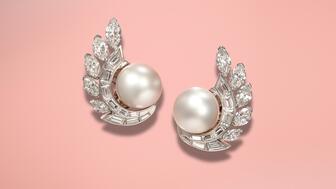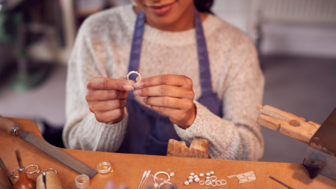An investigation found that the former managing director of Movado’s Dubai branch overstated and prematurely recorded sales.
The History Behind … The Choker
Long before they encircled the necks of goth girls in the 1990s or were popularized by a princess in the late 1800s, chokers were donned by women in ancient civilizations to protect their throats.

Long before they encircled the necks of goth girls in the 1990s or were made popular by the Princess of Wales in the late 1800s, chokers were donned by women in ancient civilizations, worn to protect what even back then they understood to be a very important part of the body, the neck.
They are a style that cuts across many cultures--African, Indian and Western among them--and class lines.
With chokers on the rise once again, Yvonne Markowitz, the Rita J. Kaplan and Susan B. Kaplan Curator Emerita of Jewelry Museum of Fine Arts (MFA), Boston, recently took the time to talk with National Jeweler about the history behind this tight-to-the-neck piece in the fine jewelry world.
Who were the first people to wear chokers? The history of the choker dates back thousands of years, to the world’s earliest civilizations, the Sumer empire in Mesopotamia and Ancient Egypt.
Markowitz said women in both these ancient worlds wore chokers, often pairing them with other necklaces, for the same reason they wore all jewelry--to protect them and give them power.
“A lot of ancient jewelry,” she observed, “is protective and amuletic.”
They put jewelry on parts of the body they felt needed protection--the throat, head, arms and ankles--and believed it infused them with special powers. This was especially true of gold jewelry, which ancient peoples associated with the sun, and lapis, which people in Egypt connected with the life-giving powers of the Nile River.
Markowitz said that women in Egypt also donned chokers comprised of four to six stands of beads held together by a vertical, zig-zagged shaped spacers. This Ancient Egyptian choker in the MFA’s collection is made of gold, with black and green beads and the wavy spacers.
When, after that, were choker necklaces really “in” again? In Western culture, high jewelry chokers are visible here and again throughout history, including during the Renaissance, with portraits from that time showing necklaces being worn high on the throat.
“It was a style that had fleeting moments,” Markowitz said, “and I guess the next big moment was at the end of the 19th century.”
As happens so often in fashion and jewelry, the affinity of a very public figure aided the choker’s reemergence.
Alexandra of Denmark (1844-1925) was on the British throne as the wife of King Edward VII from 1901 to 1910 and, before that, spent some 38 years as the Princess of Wales.
During her reigns, she became an influential figure in fashion and popularized one of her favorite pieces of jewelry, the choker necklace.
The tale that’s been told through the years is that Alexandra wore chokers to hide a childhood scar on her neck, although Markowitz noted that the story of the Queen consort’s scar has never been confirmed.
If it is true, though, Alexandra would not have been the only woman of her time to use her jewelry to hide an imperfection.
Included in the collection of the Victoria & Albert museum in London is a Kropfkette (goiter chain) made in Austria sometime between 1840 and 1870.
Kropfkettes were chokers consisting of multiple rows of chains with a large clasp at the front. Women in south Germany and Austria wore them to hide the lumps on their necks caused by goiter, a disease caused by iodine deficiency common among those who lived high in the Alps.
These chokers were not quite as fantastic as those donned by Alexandra, though; they were silver and often set with garnets.
Markowitz said chokers continued to be popular through the Art Nouveau period--René Lalique made some of the most beautiful ones ever designed, she said--and into the 1920s, becoming known as “dog collars” along the way. (She said it was Sir Charles Leonard Woolley who gave them this name following his excavations of the Royal Cemetery at Ur in what was once Mesopotamia.)
In America, the Astors wore long pearl necklaces with several strands of the pearls wrapped around their neck, while others donned just a simple black ribbon.
Then, as the Art Deco era faded in the 1930s, “(Chokers) went out, in a major way,” she said.
While there have been occasional resurgences in popular culture--the beaded chokers of the hippie era and the plastic tattoo chokers of the 1990s are two examples that come to mind--chokers crafted of fine materials never regained the same popularity they once had.
“It’s not the most comfortable piece of jewelry to wear, and it also has to be well fitted unless it’s something with a string or fabric where you can adjust it to your neck,” Markowitz observed.
Today, chokers are making their rounds again along with their seemingly more comfortable and easier- to-fit cousin, the collar, with both fine and fashion pieces finding their way into stores.
RELATED CONTENT: Amanda’s Style File: Collar Craze
In March, Vogue magazine published an article online telling readers how to “rock” a choker like the singer Rihanna and included a gallery of 10 modern-day examples, ranging in price from $9 to $1,375.
How can a jeweler add chokers to their inventory? Markowitz said jewelers looking to carry antique or estate chokers should go through a reputable estate jewelry dealer.
Before doing so, however, they should make sure there is demand among their customers for this very specific style of necklace, whether it’s vintage or modern.
“No retailer wants inventory that they can’t move. If they find that something is hot, then I’ll think they’ll want to stock it,” she said.
The Latest

The collection pays tribute to the Japanese philosophy of Ma, studying balance, stillness, and the interplay between presence and absence.

Mari Lou’s Fine Jewelry in Orland Park, a suburb of Chicago, is closing its doors.

GIA’s labs in Dubai and Hong Kong are now accepting larger diamonds in light of the “logistical challenges” presented by the new tariffs.


These earrings by Van Cleef & Arpels, featuring the same design as a pair worn by Princess Grace, are up for auction at Woolley & Wallis.

Two experts share how artificial intelligence tools can help retailers run a more efficient business.

Bench jewelers spend years honing their skills, Jewelers of America’s Certification validates their talents.

Kentaro Nishimura, who has been with the pearl company since 1997, has been promoted to president and CEO of Mikimoto America.

“America Telling Time: 150 Years of Bulova” explores the storied history of the American watchmaker.

An across-the-board tariff of 10 percent remains in place for all U.S. trading partners, except China.

Brigette Pheloung and Tania Sarin, and their mothers, star in the campaign wearing medallions they co-designed.

LeVian is remembered for her unwavering commitment to her family, community, and helping others.

The retail show is open to the public and will run July 24-27.

Editor-in-Chief Michelle Graff answers questions about how the new taxes levied on countries like India and China will impact the industry.

The new store in the upscale Iguatemi São Paulo mall is the storied brand’s first flagship in Brazil.

The pieces span from the Art Deco period to the 1970s and will go up for auction at the Paris Jewels sale later this month.

The Grammy-winning singer-songwriter, who is set to perform at Coachella this month, also debuted a curated selection from the brand.

The introductions include the Land-Dweller, Rolex’s first new model since 2012, as well as several new dials for its classic timepieces.

Cowlishaw earned a degree in horology after serving in World War II, working at one of the first Zales stores in Tulsa, Oklahoma.

Bonhams will offer the “Kat Florence Lumina” at its May 22 jewelry auction.

In March 2022, the men went into a jewelry store in Beverly Hills and smashed the display cases with sledgehammers and crowbars.

The 51 unique watches from Sotheby’s three-day sale and immersive exhibition all found buyers, with the top lot selling for $229,955.

The company has acquired Australian jewelry insurance provider Jewellers Loop.

Beau Lotto’s immersive presentation will be a blend of neuroscience, art, and entertainment.

A pink topaz Belle Époque pendant-brooch and a Victorian Egyptian Revival choker were also highlights at a recent Anderson & Garland sale.


























